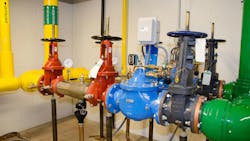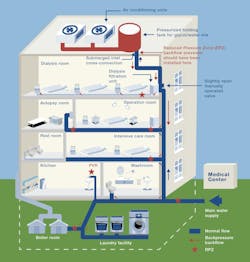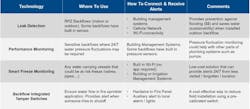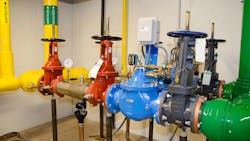Backflow Technology Comes of Age
By Nadeem Mirza, Senior Product Manager, Watts
Backflow prevention assemblies, while fundamental components in safeguarding potable water supplies, have not – in the minds of most trade professionals – been at the forefront of technological innovation.
Yet, mirroring rapid advancement seen across the broad spectrum of the plumbing and mechanical industry, this critical sector is surpassing expectation. The “world of backflow” now embraces sophisticated technologies that are fundamentally changing how we protect water sources and manage building systems.
For those in the design and engineering field and those they serve – among them, installing contractors, and facility managers – staying ahead of these developments is essential for maintaining competitiveness, system reliability and all facets of the safety equation for connected water systems.
A wealth of greatly more capable and intelligent technology is now entering the backflow prevention universe. These innovations extend beyond the basic function of preventing reverse flow, incorporating features such as easy connectivity to Building Management Systems (BMS), continuous monitoring of device performance and system conditions, and integrated safety functionalities like flood and freeze protection.
Understanding the core: RPZ assemblies
One of the most common and effective types of mechanical backflow preventers is the Reduced Pressure Zone (RPZ) assembly. RPZ backflow preventers are designed for high-hazard applications, meaning they protect against situations where a backflow event could cause serious illness or death. Their design incorporates two independently operating check valves and, critically, a hydraulically operated differential pressure relief valve located between the two check valves to provide a third line of defense, and redundancy.
The relief valve in an RPZ assembly constantly senses the pressure differential across the first check valve. In normal operation, the pressure between the two check valves (the reduced pressure zone) is maintained at least 2 psi lower than the supply pressure. This pressure differential ensures that if the second check valve is compromised, any backpressure will push water towards the relief valve, where it can be safely discharged, rather than pushing it back into the potable supply through the first check valve.
A key function of the relief valve is to provide diversion of water in the event a check valve fails, acting in essence as an informant. If the first check valve fouls or fails, allowing pressure in the reduced pressure zone to rise too close to the supply pressure (typically within 2 psi), the relief valve is designed to open.
While visible discharge is a vital safety feature, it also presents a practical challenge. Backflow preventers are often installed in areas not frequently monitored – often in out-of-the-way locations, typically out of sight. This means relief valve discharge may go unnoticed for extended periods.
Smart tech: flood detection and prevention
Addressing the risk of undetected relief valve discharge has led to the first major wave of digital technology integration into backflow preventers: flood detection and protection. These smart devices are engineered to sense the presence of water from relief valve discharge in the immediate vicinity of the backflow preventer. Upon detecting water, the system triggers an immediate alert to designated personnel.
These alerts can be delivered through multiple channels, including text messages, emails, and automated phone calls, leveraging connectivity options such as integration with existing Building Management Systems (BMS), dedicated cellular gateways, or Wi-Fi networks. The ability to receive instant notifications provides building owners, facility managers, and maintenance staff with precious time to investigate the cause of the discharge and take corrective action before the situation escalates into a major flood event.
Some non-critical water supply systems can be configured to permit automatic shut off of the water supply based on duration and magnitude of relief valve discharge/flood condition.
Why flood detection?
Water damage is the number one cause of property damage in the USA, exceeding both fire and theft in terms of financial losses. On average, commercial water damage from a minor flood event costs between $11,000 to $24,000.
Overall, water and mold damages cost $2.5B to insurance companies every year. Plus, there’s high risk of black mold in humid climates.
Beyond flooding: integrated monitoring and safety features
The integration of smart technology extends beyond just flood detection. Modern connected backflow assemblies can also incorporate sensors for other critical conditions, such as freezing temperatures.
Freeze alerts provide valuable redundancy, even in mechanical rooms that are typically heated. Unexpected HVAC failures or extreme external temperatures could still expose backflow preventers, especially those near exterior walls, to freezing conditions, potentially damaging the assembly and compromising its function. An automated freeze alert allows staff to take preventative measures, such as adding supplemental heating or insulating the device, before damage occurs.
Benefits for engineering design
The integration of connectivity and smart features in backflow prevention assemblies offers distinct advantages for engineers during the system design phase.
- Simplified specifications: Features like integrated tamper switches streamline the specification process. Instead of specifying a standard backflow preventer and a separate fire tamper switch with its own wiring requirements, engineers can specify a single unit with integrated monitoring capabilities;
- Enhanced system reliability and resilience: Incorporating flood protection connectivity directly into the design provides an inherent layer of defense against water damage. Engineers can design systems knowing there is an automated mechanism to alert facility staff to potential issues originating from the backflow preventer, reducing the risk profile of the building;
- Improved freeze protection design: While mechanical rooms typically have heating, incorporating freeze alerts adds a valuable redundancy. Engineers can specify these features to provide an extra safeguard, particularly for assemblies located in potentially colder zones or buildings where consistent heating cannot be absolutely guaranteed during off-hours or power outages.
By leveraging connected technologies, engineers can design more sophisticated, reliable, and safer plumbing systems to address potential hazards and simplify ongoing management for building operators.
For facility managers, smart and connected backflow prevention technology represents a significant leap forward. It offers...
- Remote monitoring: In today's complex buildings, backflow prevention assemblies are often located in remote mechanical areas. Visual inspection as the primary monitoring method is simply not viable for ensuring timely detection of issues like relief valve discharge or tampering. Connected technology provides remote visibility into the status of critical equipment, including fire line backflows, flood sensors, and freeze condition alerts;
- Proactive alerting: Automated alerts for flood, freeze, or tamper events allow facility managers to respond proactively. Instead of discovering a problem hours or days later (or worse, after a flood has caused significant damage), notifications are immediate. This enables rapid dispatch of maintenance personnel, minimizing downtime and damage;
- Streamlined maintenance planning: While not yet offering predictive failure data for all parameters, the current generation of smart backflow preventers provides valuable operational data and alerts.
Connected technology transforms backflow prevention from a passive installed component into an actively monitored system, providing facility managers with the tools needed to enhance safety, reduce operational risks, and improve maintenance efficiency.
Connectivity options and design considerations
Integrating connected backflow preventers into a building's infrastructure involves various connectivity options, each with its own implications for design and security. Common methods include direct integration with the BMS, wi-fi connectivity, and cellular gateways.
Watts technology, as an example, supports both BMS integration and independent operation via cellular gateways. Cellular gateways offer a valuable alternative when connecting directly to the building's IT network presents security challenges or is prohibited by IT policies. By utilizing an independent cellular connection, the backflow preventer's smart module can transmit alerts without accessing the secure building network.
When considering Wi-Fi or cellular connectivity, network security is paramount. Data transmitted from the device, even if it's just alert data, should be encrypted. Cellular connections often provide a higher level of inherent security by operating independently of the local network infrastructure. If integrating with a BMS, collaboration with the building's IT department is essential to ensure secure network integration and data handling protocols are followed.
Standards and guidelines
Specifying connected valves requires adherence to relevant industry standards, guidelines, and certifications to ensure proper function, reliability, and compliance with regulatory requirements. Engineers should reference standards from organizations such as the University of Southern California (USC) Foundation for Cross-Connection Control and Hydraulic Research, the American Society of Sanitary Engineering (ASSE), and local plumbing codes. These standards dictate the type of backflow preventer required for different hazard levels and applications, testing and maintenance protocols.
Data, reporting, and compliance
The types of data generated by connected backflow valves are primarily focused on alerts rather than raw performance data. Smart modules within the devices process sensor inputs (like pressure differential, water presence, temperature), triggering alerts when conditions deviate from normal parameters. While the modules are gathering data internally to make these determinations, raw data is typically not transmitted externally.
This approach is often taken to address data integrity and security concerns. Transmitting large volumes of raw performance data could create cybersecurity vulnerabilities.
The future of valve connectivity: towards predictive maintenance
The evolution of valve connectivity over the next 3-5 years is poised to move toward more sophisticated performance monitoring and, potentially, predictive maintenance capabilities.
Future systems could potentially monitor subtle changes in performance parameters over time – such as slight variations in pressure differentials under specific flow conditions, the frequency and duration of relief valve opening events (even minor ones), or changes in check valve sealing behavior.
This shift towards predictive maintenance, powered by enhanced connectivity and data analytics, represents a significant advancement in the ongoing effort to ensure the safety and reliability of our water systems.
Nadeem Mirza is Watts' Senior Product Manager, Backflow and Risers. He has overall responsibility for the strategy, new product development, and product management of Watts, Ames Fire & Waterworks, and FEBCO brand backflow and riser solutions.



